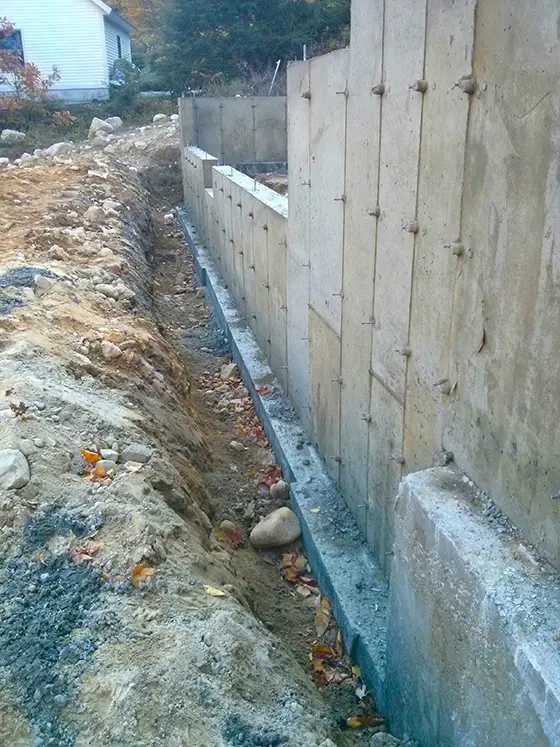DEAR TIM: I’ve got a choice to make about my new home. The builder is giving me an option as to going with a poured concrete or concrete block foundation. There’s not a huge difference in price, but I’m more concerned about the durability and strength over the long run. If you were given a choice, which one would you select and why? Is one, hands down, better than the other? Rose D., Staten Island, NY
DEAR ROSE: Congratulations on your new home! As you’re discovering, or have already, there are many decisions you need to make. It’s best to make all the decisions before you even go out to bid, but few new homeowners are that disciplined. When all decisions are made in the planning stage, the bids you get back from the builders are much easier to compare.
I think the best way for me to answer your question is to share a few stories about my personal experience with both types of foundations. I was lucky enough to live in a part of the USA where both poured concrete and concrete block were in use. What’s more, there were tens of thousands of homes that had stone foundations and almost all of these were in excellent shape after 100 years. Therein lies a clue to help you.
I grew up and had my business in Cincinnati, Ohio. Interbedded limestone and shale made up the bedrock geology of the area. Early settlers could harvest wonderful pieces of durable stone from the hillsides along the Ohio River and the nearby tributaries. This stone was easy to shape and just the right thickness to use for building home and large building foundations.
The masons stacked the stone and use a lime mortar to hold the stone together. This same method of construction was adopted by masons who would later use manufactured concrete block. The difference between the stone and block was that the stone was solid all they way through. The concrete block had void spaces to make them lighter and easier to lay in a wall.

While this poured concrete foundation looks substantial, a concrete block one can be stronger. © 2016 Tim Carter Builder
Poured concrete started to be used in the early 1900’s in the Midwest in both residential and commercial construction. The only thing that limited the final shape of the foundation was the design of the wood forms that held the wet, plastic concrete that was placed in them. With enough labor on the construction site, builders could form and pour a new foundation in just two or more days.
Concrete block didn’t require any forms to be built. A block foundation contractor that had enough masons and hod carriers could complete a large foundation in one day! It was a revolutionary building material.
All that said, what all builders, masons, architects and homeowners discovered is that both poured concrete and concrete block could crack and fail unless they were designed and constructed properly. The secret ingredient was steel. Concrete and concrete block have enormous strength when you squeeze or compress them, but if you attempt to bend or stretch either, they usually only have one-tenth the strength when compressed.
Soil pushing against a foundation wall causes them to bend. Soft soil under a foundation can cause the same bending stress. This is why reinforcing steel rods placed at precise locations in poured concrete footers are so important. This same steel needs to be placed in the poured concrete or block walls if you want to prevent cracked walls that bow inwards. Believe me, I’ve seen both poured concrete and concrete block wall failures where no steel was used. The cost to fix them is extraordinary.
Reinforcing steel can also be placed in concrete block foundations. Vertical steel bars can extend upward from the poured footer and be woven into the voids of the concrete block. Thin reinforcing steel that resembles a bar joist you often see in a large warehouse ceiling just under the roof can be placed in the horizontal rows of concrete block.
You can build a concrete block foundation that’s stronger and more durable than a poured wall so long as the block foundation has lots of vertical and horizontal steel in it and the void spaces in the concrete block wall are filled with pea-gravel concrete. I make this statement assuming the same exact poured foundation has no steel in it.
Just last week, I saw a foundation footer be installed that had no reinforcing steel. So don’t think for a moment that all footers and poured walls have this all-important steel.
The other issue is the cost of labor in your area. To build a stronger concrete block foundation as I describe is very labor intensive. There are many steps and each one needs to be done right.
On the other hand, a poured concrete foundation can be formed and poured on the same day. The foundation that is now sitting on top of the footer that has no steel was formed and poured in just seven hours! I was out of town on business the day this happened so I can’t tell you if the walls contain the needed steel. I hope so for the sake of the homeowner.
At the end of the day I feel your decision will be based on a cost comparison, but both the concrete block and poured walls need to have the mission-critical steel in them and designed correctly so you can compared the real cost between the two. Good luck!
Column 1168
Article source Poured Foundation or Block
No comments:
Post a Comment